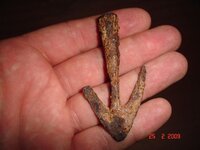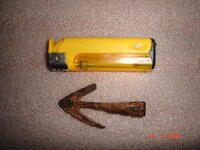Navigation
Install the app
How to install the app on iOS
Follow along with the video below to see how to install our site as a web app on your home screen.
Note: This feature may not be available in some browsers.
More options
You are using an out of date browser. It may not display this or other websites correctly.
You should upgrade or use an alternative browser.
You should upgrade or use an alternative browser.
...mediaeval arrowhead
- Thread starter yo6oej
- Start date
allen
Gold Member
- Jul 16, 2004
- 20,059
- 212
- Detector(s) used
- ace 250
- Primary Interest:
- Metal Detecting
looks like a spear head to me !! 

M
michigan michael
Guest
That is sweet! 

cntrydncr1
Gold Member
- Feb 23, 2007
- 7,806
- 777
- 🏆 Honorable Mentions:
- 1
- Detector(s) used
- ACE 250, Minelab Excal II, ETrac, Infiniuim
Wow! how cool!
spartacus53
Banned
- Jul 5, 2009
- 10,503
- 1,073
- Detector(s) used
- Ace 250
- Primary Interest:
- All Treasure Hunting
That is a great looking relic.  Sorry I can't better ID it. Maybe the UK guys will know, they are good at identifying European relics.
Sorry I can't better ID it. Maybe the UK guys will know, they are good at identifying European relics. 

hammered
Silver Member
- Aug 6, 2009
- 2,990
- 144
- Detector(s) used
- Goldmaxx Power and Canon 7D and Viagra supplier
- Primary Interest:
- Other
Hi yo6oej,
without seeing the arrow head in my hand as it were an accurate id is very hard. But having said that the " experts" at the archery club I go to said that your example was possibly a type 14 swallow tail or even a curved broadhead. The following will explain the use for the design of your arrowhead:-
"The Broadhead
Broadheads in general are characterized by a wide and flat profile with long cutting surfaces, primarily suited for slicing through flesh. Early broadheads used by the Anglo-Saxons were not "barbed" and were used for hunting large animals like boar, deer and elk as well as against men in times of War.
Later broadheads were more often "barbed" so that once the arrow penetrated, movement by the prey, regardless of man or beast, would cause continued penetration and internally slice muscle tissue and organs. When attempting to remove a barbed broadhead, one would have to break off the fletching to reduce the chance of infection and push the arrow through. Simply withdrawing the barbed broadhead would cause it to lodge into the tissue causing tearing and greater damage and often the head was not pinned to the arrowshaft so if the arrow was withdrawn the head would come loose and remain in the body.
A variety of these barbed type heads were common. Small straight broadheads were used for hunting small to medium game and human targets during War. This type was used at the Battle of Bosworth. Larger straight broadheads were used for hunting medium to large game.
Curved Broadheads were somewhat larger and used for hunting larger game at short distances. The curved cutting surface more easily sliced muscle and flesh to cause severe bleeding and immobility. These were sometimes used against horses to severely reduce the mounted knights advantage in combat. To maximize the cutting surface the Swallowtail broadhead featured extremely long barbs. They flew well and cut deep and were used in the Battle of Agincourt. "
I hope this helps
hammered
without seeing the arrow head in my hand as it were an accurate id is very hard. But having said that the " experts" at the archery club I go to said that your example was possibly a type 14 swallow tail or even a curved broadhead. The following will explain the use for the design of your arrowhead:-
"The Broadhead
Broadheads in general are characterized by a wide and flat profile with long cutting surfaces, primarily suited for slicing through flesh. Early broadheads used by the Anglo-Saxons were not "barbed" and were used for hunting large animals like boar, deer and elk as well as against men in times of War.
Later broadheads were more often "barbed" so that once the arrow penetrated, movement by the prey, regardless of man or beast, would cause continued penetration and internally slice muscle tissue and organs. When attempting to remove a barbed broadhead, one would have to break off the fletching to reduce the chance of infection and push the arrow through. Simply withdrawing the barbed broadhead would cause it to lodge into the tissue causing tearing and greater damage and often the head was not pinned to the arrowshaft so if the arrow was withdrawn the head would come loose and remain in the body.
A variety of these barbed type heads were common. Small straight broadheads were used for hunting small to medium game and human targets during War. This type was used at the Battle of Bosworth. Larger straight broadheads were used for hunting medium to large game.
Curved Broadheads were somewhat larger and used for hunting larger game at short distances. The curved cutting surface more easily sliced muscle and flesh to cause severe bleeding and immobility. These were sometimes used against horses to severely reduce the mounted knights advantage in combat. To maximize the cutting surface the Swallowtail broadhead featured extremely long barbs. They flew well and cut deep and were used in the Battle of Agincourt. "
I hope this helps
hammered
treasurefiend
Gold Member
- Mar 17, 2008
- 7,445
- 93
- 🏆 Honorable Mentions:
- 1
- Detector(s) used
- Minelab_Excal_II Minelab_Explorer_SE_Pro w/ SunRay pinpointer & Garrett_Ace250
- Primary Interest:
- All Treasure Hunting
That is so cool!!!!!!! 





Bavaria Mike
Gold Member
- Feb 7, 2005
- 8,340
- 177
- Detector(s) used
- Minelab XT70, Fisher 1280, Garrett Ace 250 and MH5
- Primary Interest:
- All Treasure Hunting
Very nice arrow head! Congrats and HH, Mike
Silver Searcher
Gold Member
Great find  a nasty looking piece of weaponry though
a nasty looking piece of weaponry though 
SS.
 a nasty looking piece of weaponry though
a nasty looking piece of weaponry though 
SS.
Top Member Reactions
-
 3465
3465 -
 2121
2121 -
 2001
2001 -
 1109
1109 -
 1041
1041 -
 1027
1027 -
 858
858 -
 839
839 -
 823
823 -
 770
770 -
 752
752 -
 672
672 -
 650
650 -
 578
578 -
 549
549 -
 440
440 -
 432
432 -
 429
429 -
E
409
-
 403
403
Users who are viewing this thread
Total: 2 (members: 0, guests: 2)










